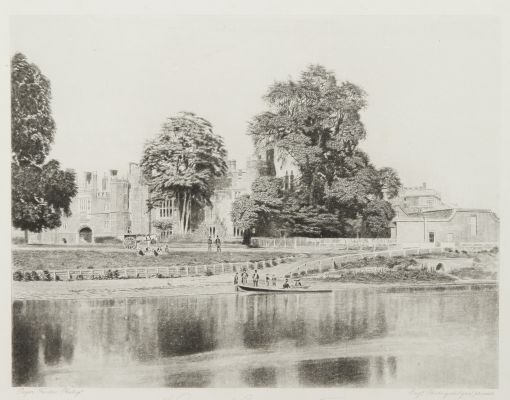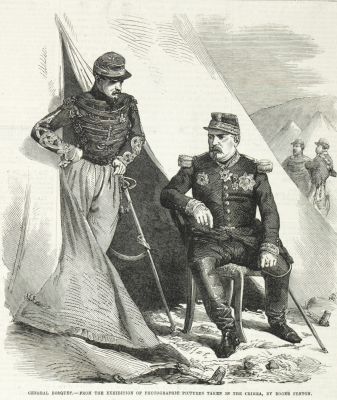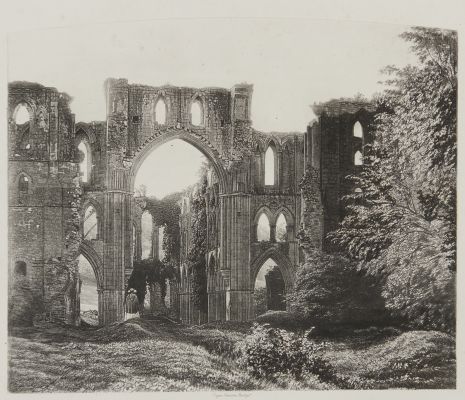
Title
Into the Woods at Bolton AbbeyArtist
Fenton, Roger (British, 1819-1869)Date
1856Process
PhotogalvanographAtelier
Paul PretschImage Size
29.5 x 35.5 cm
Mostly now forgotten, in 1854 Paul Pretsch invented one of the fist viable processes for printing photographs in ink. He named it Photogalvanography and launched a business concern, The Photo-Galvano-Graphic Company, to monetize it. One of the first professionals to be impressed by the process was Roger Fenton who recognized the potential of the process for his own work. Fenton partnered with Pretsch and was appointed head of the Photographic Department of the company. When specimens of these productions were laid before him… he was struck with the great ingenuity of the thing, and although he had a preconceived opinion against the success of the application of photography to engraving, at the same time he saw so much that was beautiful in this new process, that he could not but encourage Herr Pretsch to proceed with it.” Fenton believed that it “would supersede almost every other method of reproducing natural objects. He thought, with the assistance of photographers and the engraver’s art…the question of intaglio engraving was settled by this invention. [1]
The company began its activities with the much-anticipated publication of Photographic Art Treasures (December 1856). Photographic Art Treasures was planned as a series of monthly editions, each part containing four photogalvanographed prints. The Company naturally hoped to become a profitable business, but it advertised a higher purpose. The New Era in Art, as it was proclaimed, was to enable ordinary people for the first time to see and have in their own homes reproductions of great works.
Part I had emerged in November of 1856, Part II in January 1857, but thereon slowed. The first number was illustrated by four photogalvanographs from photographs by Fenton, the second included the photographers William Lake Price, William Howlett and Lebbin Colls. Unfortunately, by 1858 after only five issues, the company, plagued by lawsuits and lack of funds, effectively collapsed.
Examples of photogalvanographs are rare. Most examples found are from Photographic Art Treasures folios. The above image, Into the Woods at Bolton Abbey, is an exception. It is large and lacks accompanying text below the image. Only one other example has been found at the V&A in London.
Amateur historian Paul Morgan has conducted extensive research on Pretsch, Fenton and this print. He has dated it to 1857. While there is very little information available, there is advertising on the folio covers of Photographic Art Treasures for an upcoming portfolio of Fenton’s Bolton Abbey photographs. The portfolio was never realized before the company was closed.
From Morgan’s notes…Plates wore out quickly; the photogalvanographic portfolios were expensive, the company was on the point of dissolving, and the hypothetical Bolton portfolio may have been published in smaller numbers than the already low print runs. As it is, any photogalvanographs from Fenton are uncommon, so it should be no surprise that hitherto unknown items produced during the last days of the company can have gone missing for years. Alternately, further portfolios may not have been published, although photogalvanographic plates might have been prepared, with copies pulled, before the enterprise folded. This possibility is suggested by the lack of a printed text on the mount.
It is my opinion, however, that this print was never intended for a portfolio. It is significantly larger and more substantial than anything produced for Photographic Art Treasures. And considering it is almost identical in dimension to Fenton’s albumen print of the same image, one must consider it a print by Fenton for exhibition. This theory would better explain the lack of type under the image, the large size and the print’s rarity.
Regardless of the story behind this print, it stands up today as a fine and beautiful example of Fenton’s work and the best photogalvanograph I have ever seen.
You can read Morgan’s essay here: https://photogravure.com/wp-content/uploads/2018/03/PhotographicArtTreasures.pdf
Reproduced / Exhibited
Exhibited: The Age of Salt. Art, Science and Early Photography, James Hyman, 16 Savile Row, London W1, 2015
References
[1] Sutton. Photographic Notes. London: Bland, 1856.
Humphreys Journal: Vol XI, No. 15, of Dec 1 1859, page 239, No. 25 of Sept 15 1868 page 393/4
Morgan, Paul Uncovering the Covers of ‘Photographic Art Treasures’: A New Insight Into Old Technology
Goldschmidt & Naef, The Truthful Lens (1980) No. 131.
Hannaway, Roger Fenton of Crimble Hall [1976] 65-67











